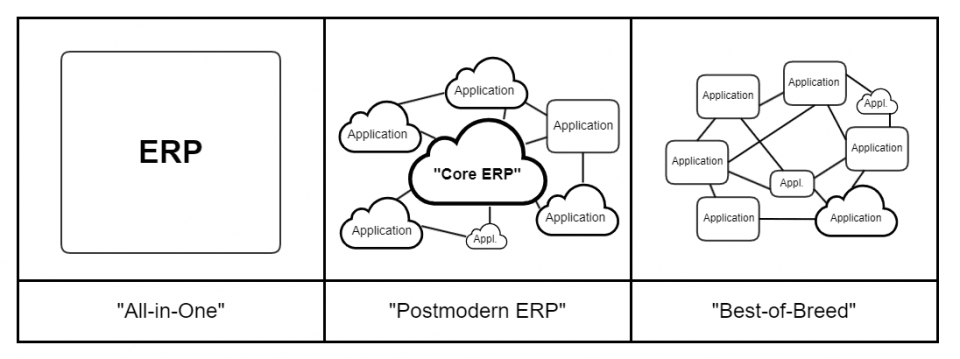When designing an ERP-based business solution for implementation in an organization, there will always be someone that raises the question of whether the design is going in the right direction.
Will the planned solution be able to exploit the possibilities of the current technology in the best possible manner? Do we make some architectural choices now, which will result in a solution must be redone at a later stage to keep up with the future technological development? And so on…
One way to secure against such issues is to look at the current ERP strategies and trends that EPR software producers and other business software providers use as guidelines when developing their application portfolios.
“Postmodern ERP” is an ERP strategy that has gained a broad following and is currently one of the most commonly used approaches for how ERP solutions should be implemented in organizations today. (P.S. this post is written in January 2021)
“Postmodern ERP” was first introduced by the Gartner Group, while the meaning behind this term has evolved since it first appeared. An interpretation of what “Postmodern ERP” represents is illustrated below.

The figure above shows a simplified illustration of “Postmodern ERP”. As the figure indicates, historically, organizations have often been left with two choices when it comes to the application of ERP systems in their organizations.
On the one hand is the traditional ERP approach or “All-in-One”, whereas much as possible of the functionality and system support is put into a single (ERP-)application.
On the other hand; the organization can choose to not use an ERP solution at all, but rather select the best possible application for each function and integrate these into a so-called “Best-of-Breed” solution.
“Postmodern ERP” has (in practice) shown to be something in between these two traditional ways of thinking around the implementation of ERP-systems.
A typical “Postmodern” solution consists of an ERP core (preferably in the cloud) where key accounting- and/or logistics functions is b being managed. Other applications and components are then connected to this focused ERP core to create an integrated business solution consisting of software running in both the cloud as well as installed on on-premises servers.
It seems like the majority of the ERP software producers do support this “Postmodern” mindset today as well; by offering an ERP solution together with a whole portfolio of surrounding applications in the cloud.
There are a trend where ERP producers are just as much focusing on developing functions within CRM, HRM, BI, Workflow engines, “Apps” frameworks, “iPaaS platforms”, “App-stores” etc, etc. that expanding the functionality of their ERP software. I will soon make a post to illustrate what ERP vendors like SAP, Oracle, and Microsoft are doing in the cloud.
What functions that an organization should be put in the “ERP core” and what should be put in applications outside the core is always a topic of discussion.
A rule of thumb is that ERP systems are very well suited for handling basic financial- and logistics transactions and therefore should these tasks be supported by the ERP core. While functions that do not directly generate or process transactions that end up in the chart of accounts can be but in applications outside the ERP-core.
If you still are unsure what should be in the ERP core versus outside. I recommend clicking here to get my and Erlend’s book. This book gives an overview of core functions that should be put in such an ERP-core, as well as some add-on software that is commonly used in manufacturing and supply chain environments.
Using a “Postmodern” way of thinking when designing the solution architecture in your own organization may make it easier to exploit the available technology in the market. This because many of the ERP software producers are forming their technology offerings in the cloud in correspondence with this mindset.
Of course, nothing lasts forever, and this current “Postmodern” trend will end with time. However, by always following the major way of thinking around ERP-strategies in your organizations; you will at the same time also follow the natural developments of the ERP software producers and other technology providers as they are adjusting their solutions and offerings to meet the current thinking and demand of their customers. This will open for a future proof solution that will be able to evolve according to the latest thinking and technology trends.
Therefore I do not recommend following an “all-in-one” or a “best-of-breed” mindset when designing ERP-based business solutions today. Organizations should rather use a “Postmodern” mindset where core ERP applications act with associated tools to create an integrated total solution that fulfills the requirements of the organization.
